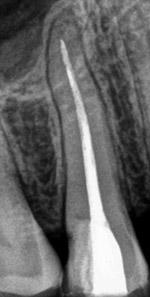Root Canal Treatment
When is Root canal treatment necessary?
When decay is allowed to advance deep into a tooth, it eventually reaches the tooth ‘pulp’. The pulp is where blood vessels and nerve fibres are located within a tooth to keep a tooth vital. This is why teeth feel sensitive to cold and can cause pain. Decay is essentially bacteria eating into a tooth and when the bacteria get access to the pulp, they proliferate and eventually cause an infection within the tooth, all the way down to the spaces within the roots of the tooth. If left untreated, the infection can keep spreading from the tooth and into the adjoining jaw tissues, causing pain and sometimes swelling of the face or jaw.
If the tooth is not too damaged by the decay, it can still be salvaged with root canal treatment.
Root canal treatment usually involves 3 visits. There is usually an interval of 1-2 weeks between each visit.
The first 2 visits involve cleaning the infected pulp out of the tooth and root spaces or canals. This usually leads to an alleviation of pain and swelling.
The 3rd visit is where the root spaces are filled and sealed to prevent re-entry of bacteria. The rest of the tooth can then be filled with a filling material to replace tooth structure lost from decay.
Radiographs are a necessity during root canal treatment of a tooth. This is because the dentist cannot see below the gum line how the root structure looks like and needs to take images (X-ray images with radiographs or cone beam scans) to allow them to carry out the procedure adequately.
Usually, a crown is then placed over the tooth. This is often necessary as the remaining tooth structure might be quite diminished and weakened from the initial decay and the crown ensures it is protected from chewing forces and does not fracture. Read about crowns here.
Root canal treatment must be carried out with the use of a rubber dam.
This is a legal requirement.

Tooth isolated with rubber dam for root canal treatment
This is because strong disinfecting solutions are used to cleanse the tooth as well as small, fine instruments called files that are used to clean the fine canals within the roots. The rubber dam ensures there is no risk of accidental ingestion and/or aspiration of these solutions and instruments. The rubber dam also ensures a dry operating field and prevents contamination of the tooth with saliva as it is being treated.
Root canal treatment need not be painful as the tooth is anaesthetised. The appointment can vary in length from 45 to 90 minutes depending on the tooth being treated.
Severe toothaches that last for prolonged periods can be caused by infected teeth. Leaving the problem untreated can result in severe swelling and infection that can become life-threatening. In such cases, it is advised you see your dentist as soon as possible.

Radiograph image of root canal treated tooth.
Why do root canal treatment?
If root canal treatment is not carried out, the infection can spread from the tooth into the surrounding tissues. In the past, before modern dentistry existed, an infected tooth could be fatal due to swelling of the tissues causing blockage of the airway or due to septicaemia. To stop the infection from spreading, root canal treatment is a necessity. If root canal treatment is not possible or is not the preferred option, extraction of the tooth is the only alternative.
What if root canal treatment is not possible?
The only alternative treatment is extraction. The tooth is then lost and there will be a gap in the dentition. The missing tooth can then, if desired, be replaced with a bridge or an implant.
What are the risks and complications of root canal treatment?
Perforations:
To remove the infection from the tooth, the dentist must drill into the tooth until they get access to the inner pulp chamber and then find the openings to the canals within each root. If there are blockages in the pulp chamber or the tooth anatomy is unusual, it can be difficult to find the canal openings which can increase the risk of drilling too much in the wrong area and causing a perforation. A perforation is an unwanted communication between the inside of the tooth and the surrounding oral environment. This, then causes an entry point for bacteria, making it hard to keep the tooth free from infection.
Some perforations can however be repaired adequately, which allows the tooth to be salvaged.
Broken instruments:
Root canal treatment involves the use of very fine instruments called files to clean within the root spaces. Nowadays, these files are made of very flexible nickel-titatium alloys and can adapt to the shape of the roots very well. However, in some cases, where the roots are very curved or narrow, there is an inherent risk of the file breaking within the root canal while in use even if all necessary precaution and care are taken.
A broken file does not necessarily mean that the tooth is not salvageable.
Broken files can be retrieved or bypassed. As long as the infected material has been adequately cleaned from the canals, a tooth with a broken file can be salvaged and not cause further symptoms.
Discoloration of the tooth after root canal treatment:
A tooth can turn grey after having root canal treatment. The material used to fill the root canals after they have been cleaned is similar to natural rubber. This material releases a pigment over time which diffuses into the tooth substance, causing a grey discoloration.
To avoid the tooth turning grey, it is important to only fill the root canals to just below the gum line. If this is done properly, only the roots of the tooth turn grey but since they are under the gum line, they are not visible.
The tooth will turn grey only if there is excessive material that overflows into the visible part of the tooth above the gum line.
If a tooth has turned grey after root canal treatment, it can be whitened again by placing bleach inside after removing the excess rubber material.
Is root canal treatment painful?
Root canal treatment is carried out under local anaesthesia, similar to when a filling or extraction is carried out.
If the local anesthetic has been administered adequately, the tooth and surrounding area are usually deeply numb and there is no discomfort during the root canal treatment.
If the tooth is very painful to start with, it can still be uncomfortable even with good anaesthesia. In such cases, taking anti-inflammatories before treatment can help improve the efficacy of anaesthesia.
When is referral to an Endodontist (root canal treatment specialist) needed?
Root canal treatment can sometimes be complex if access is difficult or the tooth has very curved or narrow root canals.
In cases where the complexity is deemed to be high, referral to a specialist endodontist will be deemed necessary and our dentist will do so to ensure you receive the best treatment possible.



